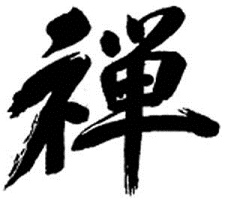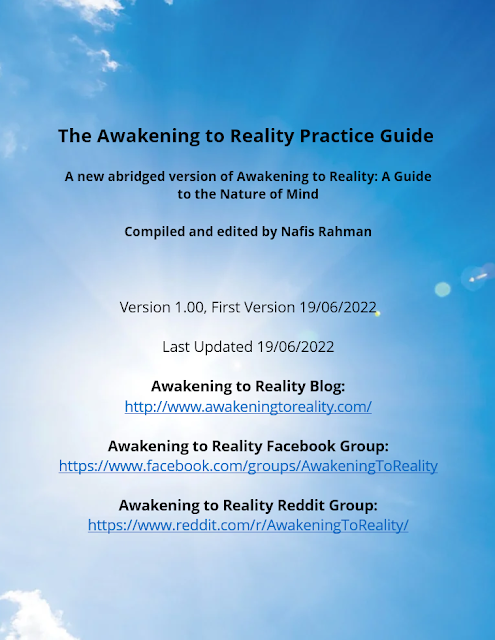Just some random short notes I have been wanting to jot down, reflecting my current understanding as experiential insight deepens in my practice.
....
Many people mistaken letting go and dispassion in terms of dissociation (a subject 'letting go' and 'standing back' from object). This is not true letting go or dispassion.
'In the seen just the seen' with no 'you in terms of that' is true dispassion. It is the state where each sound, each color, each sensation is happening on its own, manifests on its own as its own radiance, and yet there is completely no additional fabrication, or whatever kind of identity in relation to that. This complete emptiness of any kind of identity and clinging or subject-object relation in relation to 'in the seen just the seen', 'in the heard just the heard' is true dispassion.
A dissociated state is just another form of grasping, attachment. It is attaching at 'something' or 'someone' being more true and real than the rest of the field.
....
Therefore, it is always the eventuality of every practitioner to discover that spontaneous perfection is the only course of liberation. Yet one must also be wary of falling into a nihilistic extreme of interpreting non-action as not needing practice or effort. We still have to meditate, but this meditation becomes directionless (or more accurately, aimlessness and wishlessness -- one of the three doors of liberation) and without subject-object (I'm here, trying to get 'there') but immediate practice-enlightenment or instant actualization in every encounter or activity, sitting, walking, working, encountering people. This effort is not the same as the dualistic effort of trying to attain a result in the future, or trying to sustain a subject/object structure by bringing in a dualistic form of watching.
There can and should be effort and focus in practice, but this effort and focus is applied in a way that completely dissolves the subject/object structure rather than retain or strengthen it, for example when being mindful of the breathing, the breathing is its own attention and awareness, there is no dualistic attempt to 'shine the spotlight of awareness on an object or a subject'. Effort and focus, and effortlessness becomes one. This is why Dogen's teachings are very useful here to counteract the nihilism of the wrongful understanding of non-action. The kind of "doing" or "action" we should be rid of is not "don't have to make any effort" but "not being affected by results/gain/loss", for it is the attachment to the results that are karmic. Each step, each breath, becomes the ends rather than the means -- it is the actualization of enlightenment/Buddha-nature rather than a means to get enlightenment in the future.
And this, also happens to be true non-meditation and non-action, beyond the sense of there being a meditator-meditation and actor-action.
....
Many people mistaken letting go and dispassion in terms of dissociation (a subject 'letting go' and 'standing back' from object). This is not true letting go or dispassion.
'In the seen just the seen' with no 'you in terms of that' is true dispassion. It is the state where each sound, each color, each sensation is happening on its own, manifests on its own as its own radiance, and yet there is completely no additional fabrication, or whatever kind of identity in relation to that. This complete emptiness of any kind of identity and clinging or subject-object relation in relation to 'in the seen just the seen', 'in the heard just the heard' is true dispassion.
A dissociated state is just another form of grasping, attachment. It is attaching at 'something' or 'someone' being more true and real than the rest of the field.
....
There's absolutely no need to attempt to bring anything whatsoever, presence, witnessing, whatever, into sleep or any states (waking, dreaming, and deep sleep). Any dualistic effort is a form of doing. Bringing in a watcher is karma. All dharmas, all phenomena, are fundamentally quiescent as nirvana, fundamentally non-arising and naturally manifesting as one's own state of radiance. Therefore true practice is resting in the natural, spontaneous perfection of luminosity and emptiness. Practice becomes dynamic rather than technique-bound as the spontaneous unfolding or self-arising of all displays, activities, sounds, colors, sensations, gets auto-actualized as the wisdom of luminous-emptiness. Everything arises as the state of meditation, which is non-meditation. Yet this requires anatta and emptiness as pre-requisite.
Therefore, it is always the eventuality of every practitioner to discover that spontaneous perfection is the only course of liberation. Yet one must also be wary of falling into a nihilistic extreme of interpreting non-action as not needing practice or effort. We still have to meditate, but this meditation becomes directionless (or more accurately, aimlessness and wishlessness -- one of the three doors of liberation) and without subject-object (I'm here, trying to get 'there') but immediate practice-enlightenment or instant actualization in every encounter or activity, sitting, walking, working, encountering people. This effort is not the same as the dualistic effort of trying to attain a result in the future, or trying to sustain a subject/object structure by bringing in a dualistic form of watching.
There can and should be effort and focus in practice, but this effort and focus is applied in a way that completely dissolves the subject/object structure rather than retain or strengthen it, for example when being mindful of the breathing, the breathing is its own attention and awareness, there is no dualistic attempt to 'shine the spotlight of awareness on an object or a subject'. Effort and focus, and effortlessness becomes one. This is why Dogen's teachings are very useful here to counteract the nihilism of the wrongful understanding of non-action. The kind of "doing" or "action" we should be rid of is not "don't have to make any effort" but "not being affected by results/gain/loss", for it is the attachment to the results that are karmic. Each step, each breath, becomes the ends rather than the means -- it is the actualization of enlightenment/Buddha-nature rather than a means to get enlightenment in the future.
And this, also happens to be true non-meditation and non-action, beyond the sense of there being a meditator-meditation and actor-action.
"One time, Huineng, old Buddha of Caoxi, asked a monk,
"do you depend upon practice and enlightenment?."
The monk replied,
"It's not that there is no practice and no
enlightenment. Its just that it's not possible to divide them".
This being so, know that the undividedness of practice
and enlightenment is itself the Buddha ancestors.
A walk with Dogen into our time xxv
The Essential Dogen: Writings of the Great Zen Master"











